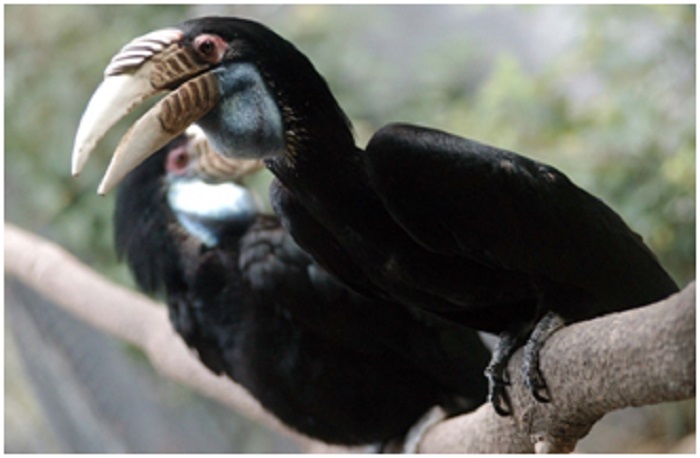



Bird watching is now a byword of poverty alleviation in Shiti village, Taiping township of Yingjiang county, southwest China’s Yunnan province.
By rationally exploiting ecological resources, especially the birds, the annual per capita income of the village has been raised to 10,152 yuan ($1,552) last year from less than 2,000 in 2014.
“Niaotang,” or bird-watching pond, is a bird-watching mode developed by the residents in Shiti village. It has been attracting a large number of visiting birdwatchers to the village. In the pond, several stumps are placed, which are stuffed with mealworms, a perfect feed for birds, and a shack is built around 10 meters away from the pond, where birdwatchers can shoot photos of the birds that are foraging and playing in the pond.
Niaotang serves as a source of considerable income for the villagers, as birdwatchers are not only provided with spots for camera stands, but also meals and accommodation.
Cai Wu is a villager in Shiti. Five years ago, he was still a registered impoverished resident who lived on a lemon grass field less than 1 hectare with his family. Back then, the family of five could only make less than 5,000 yuan each year. In November, 2015, he and his fellow villagers co-built two bird-watching ponds, thanks to which he bid a farewell to poverty the next year.
“Birdwatchers are different from average visitors, as they would always stay for days and even a couple of months to discover their target birds,” Cai told the People’s Daily. Three years ago, the man started working as a “bird guide” for birdwatchers, taking the latter to and from different bird-watching ponds with a car he bought, which further increased his income.
His ponds and guiding service earned him over 60,000 yuan last year. “It’s unbelievable that the ordinary birds could become a source of income for us,” he said.
Ban Dingying, head of a bird-watching society in Yingjiang county, introduced that Shiti village, adjacent to a provincial-level nature reserve, boasts complete rainforest ecosystem and rich resources of birds. It is home to over 350 bird species, which account for 24.7 percent of the known species in China, and some of them have only been discovered in Shiti village, Ban said. In 2019, the village was visited by over 20,000 birdwatchers.
Situated near the border between China and Myanmar, Shiti houses 363 residents from 85 households of Jingpo and Lisu ethnic groups. Lumbering and hunting were major ways for the villagers to make a living in the past. However, they not only failed to get the villagers out of poverty, but also undermined local ecology. In 2014, the village was home to 43 registered impoverished households, which led to a poverty incidence of 50.6 percent.
Yingjiang county’s idea to develop bird-watching tourism was inspired by Baoshan, a neighboring city of the county which benefited from its bird resources. Yingjiang’s cadres believe that their county can do better, as Yingjiang is home to hornbills, a “star” species in the bird-watching community.
Since 2015, Yingjiang started working on bird-watching tourism to help its poverty alleviation. Under the guidance of local government, bird protection has become a consensus for local community, and hornbills, which once disappeared in Shiti village, have come back due to the improved environment.
Shiti village is now a stable breeding place for great hornbills, wreathed hornbills and lesser pied hornbills, said Ban, adding that the village is a place with the highest possibility to discover wild hornbills in China. It is nicknamed “Chinese hornbill valley,” he told the People’s Daily.
Given the booming bird-watching tourism, the local government encouraged residents to quit lemon grass planting and develop green economy. Shiti village has grown 187 hectares of nuts, litchi and coffee beans, generating revenue of over 300,000 yuan each year.
“The COVID-19 pandemic has impacted the bird-watching tourism this year, but the nuts business was thriving,” Yang Hongfei, deputy Party head of Taiping township, adding that Cai had gained over 10,000 yuan from nut planting.
Ban told the People’s Daily that the first half of a year is usually a high season for bird watching. “The business was gloomy due to the epidemic earlier, but things are looking up now, he said, adding that Shiti village is well-prepared for the recovery of the bird-watching tourism.


The Executive and members of the.


The Acting Director, FCT Directorate of.


President Bola Ahmed Tinubu has been.



Barely a month after resignation of.


An Abuja based Legal Practitioner, Osuagwu.



Convener of Equitable Remedy, Mrs. Magaret.


Contractors handling the contract for city.


Nigerian government may have concluded plans.


The Diplomatic Correspondents Association of Nigeria.


A rights group, “Follow Me Talk.
Leave a Comment